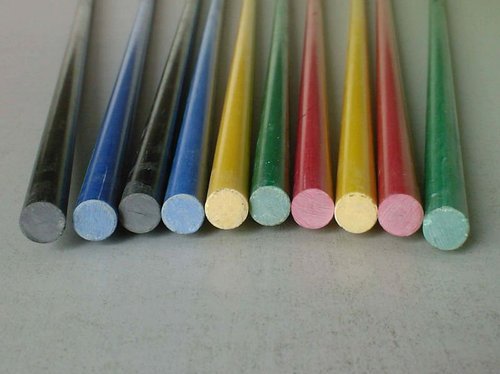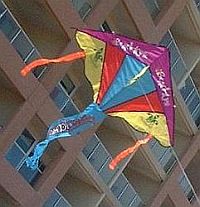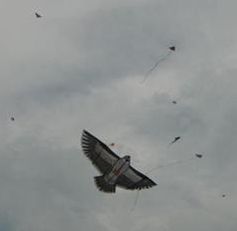- Home Page
- Accessories
- Fiberglass Rods
Fiberglass Rods
The Most Popular Kite Spar Material
Fiberglass rods are found in the great majority of affordable sparred kites.
 Fiberglass rods
Fiberglass rodsBut you know me; this is not just a dry technical discussion of kite construction! I have done a spot of research to uncover just a few extra snippets of interesting info.
The low cost of fiberglass keeps fancier alternatives like carbon fiber or graphite from dominating the manufacturing and sales of kite-spar material.
Carbon fiber is wonderfully light, stiff, and strong. As it eventually gets cheaper, I suppose it could even become the "bamboo" of the 21st century as far as kite making is concerned!
But for now, fiberglass is cheaper, with very respectable properties for making things that fly. Also, very thin and therefore bendy lengths of fiberglass are handy for special applications like the wedge tail of an eagle kite.
On this site, there's more kite-making info than you can poke a stick at. :-)
Want to know the most convenient way of using it all?
The Big MBK E-book Bundle is a collection of downloads—printable PDF files which provide step-by-step instructions for many kites large and small.
Every kite in every MBK series.
Of course, the cheapest way to make kite frames is with hardwood dowel, like various types of oak. It's quite strong and light enough for very respectable performance if chosen well.
For making quite small kites, bamboo skewers purchased in bulk are even cheaper by a large margin!
Made With Fiberglass Rods
A Delta and an Eagle
 Our "Windjam Delta"
Our "Windjam Delta"Now to mention a couple of kites (constructed with fiberglass spars) that we have flown.
We had a Windjam Delta a few years ago, a typical mid-sized store-bought kind of design. There it is in the photo.
This delta flew straight and had a reasonable wind range, not to mention a nice high line angle. We eventually lost it, but that's another story.
The point is, a modern ripstop-nylon kite with fiberglass spars is very durable and reliable in good flying conditions. Some designs are better fliers than others, though.
Rods made from fiberglass bend and can take
quite some punishment, like careless handling during transport. Or an
inexperienced flier might manage to smack it nose first into hard ground!
 "Light-Wind Eagle"
"Light-Wind Eagle"Some time ago our family visited Singapore, and it was there that I flew my brother-in-law's Light-Wind Eagle.
That's it in the photo.
True to its name, this fiberglass-sparred bird kite did a very good job of staying up in quite light air.
It's hard to describe the exact configuration of this design without having it here right now to look at. Suffice to say, the long bowed fiberglass spreader kept the very realistic wings outstretched.
At the crowded park where we flew, we spotted one or two other identical eagle kites. Hey, if you can't fly like a bird, why not fly one on the end of a string!
More on Spar Materials
The two most important parameters of spar materials are weight and stiffness. The size, sail shape, and desired wind range of a kite determine the stiffness needed. From there, the lighter the better, although the very lightest spar materials will also make your wallet lighter.
The nice thing about man-made materials like fiberglass or graphite is the great homogeneity
of the rods. This means weight and stiffness are very uniform along the
entire length of such a spar. This is unlike a typical length of wooden dowel from the
local hardware store! Pro kite-makers select dowel carefully, making
sure stiffness is very similar on both sides of the kite.
Personally, I like to file away some wood to bring a newly constructed kite into perfect trim!
While on the topic of rods, I should mention hollowed-out rods or tubes. These represent a further weight saving for a given strength or stiffness. But solid rods are fine for small- to medium-sized designs. However, they are much heavier than wooden dowels of the same diameter.
Companies that manufacture rods from fiberglass don't just sell to kite people, of course. Just about every application that requires a flexible rod now has something already available in fiberglass. This includes beach tents, golfing flagpoles, you name it! In fact, some of these have actually ended up in large homemade kites. For example, some people have made fishing-rod spars.
As mentioned earlier, there's more kite making on this site than you can poke a stick at. :-)
Want to know the most convenient way of using it all?
The Big MBK E-book Bundle is a collection of downloads—printable PDF files that provide step-by-step instructions for many kites large and small.
That's every kite in every MBK series.
